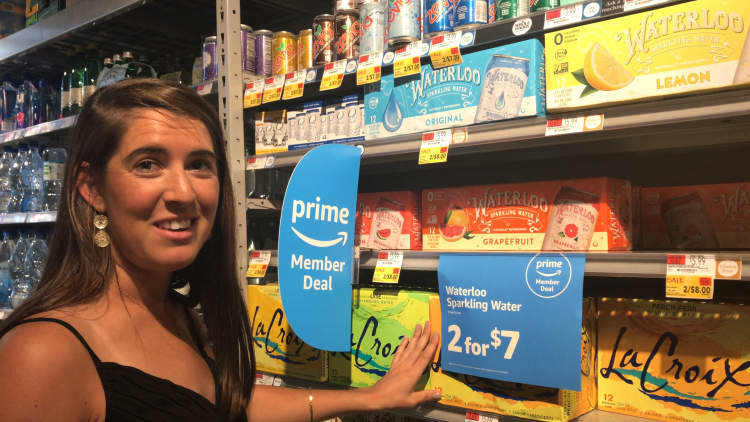The average American expects to spend around $1,000 this holiday season, according to the National Retail Federation. No matter how much you plan on spending, as long as you pay your bills in full and on time, you can save some real money by using the right credit card.
Finding the right card, though, can be a challenge. Some offer better rewards than others, and many require an annual fee. And the right card for you will depend on how you spend your money.
To determine which cards offer the best deals for holiday shoppers, CNBC Make It looked at 50 popular credit cards in the U.S. We considered a wide range of factors, including rewards, ease of use and perks, as well as downsides such as interest rates and fee structures.
Based on the data, here are our top picks.
If you shop at department stores
The Chase Freedom offers 5 percent cash back on purchases in multiple great categories that change every quarter, and 1 percent on all other purchases.
This quarter it promises 5 percent back on spending at a variety of department stores and wholesale clubs including, for example, Costco, J.C. Penney, Nordstrom and Macy's. General purchases made through Chase Pay also get you 5 percent back.
That offer applies for the entire fourth quarter of 2018 until you spend $1,500, at which point you'll have made $75 in cash back.
Cardholders must activate rewards each quarter if they want to earn 5 percent back. This quarter the deadline is December 14. Earlier this year, categories featured rewards for spending at gas stations and grocery stores. Categories for 2019 have not yet been announced.
The perks offered by the Chase Freedom are great for holiday shopping. Purchases are protected up to $500 against damage or theft for 120 days.
The card also extends warranty offers from U.S. manufacturers an additional year.

Users who spend $500 within first 90 days receive a $150 bonus, and the card has a generous introductory offer. On balance transfers and purchases, cardholders initially get annual percentage rates of 0 percent for 15 months. Thereafter the APR is 16.99 to 25.74 percent.
The Chase Freedom card saves you even more money if you take advantage of an extra perk: Pair it with a card like Chase Sapphire Preferred in the same Chase account, and you can convert your cash back points to Ultimate Rewards points, which are more valuable when redeemed on travel.
At a glance:
- Rewards: 5 percent on up to $1,500 in combined purchases in spending at department stores and wholesale clubs this quarter; unlimited 1 percent on all other purchases
- Annual fee: $0
- Bonus: $150 if you spend $500 within first 90 days
- Variable APR: 16.99 to 25.74 percent based on your credit score, after 0 percent on purchases and transfers for first 15 months
- Notable perks: Purchase protection; extended warranty protection
If you shop on Amazon
If you are doing most of your holiday shopping on Amazon, the site's Prime Rewards Visa Signature, issued through Chase, may be the best card for you.
It offers some enticing rewards: 5 percent back on purchases you make on Amazon and at Whole Foods, as well as 2 percent back at restaurants, gas stations and qualifying drug stores, plus 1 percent on all other purchases. When you sign up, Amazon also throws in a $70 gift card.
Users receive benefits from the Visa Signature Luxury Hotel Collection and some travel coverage, including a damage waiver on auto rentals. There's no foreign transaction fee, so you're free to use it outside the U.S. without paying extra.
Although the card technically doesn't have an annual fee, it is exclusive to those who pay for Prime membership, which costs $119 per year. The APR is 16.24 to 24.24 percent.

If you decide Prime membership isn't worth the fee, you can still qualify for the Amazon Rewards Visa Signature Card. This card has a structure similar to the Prime Rewards card, except it only offers 3 percent back at Amazon.com and Whole Foods, not 5 percent, and a $50 gift card bonus rather than a $70 bonus.
The Prime Rewards card is the better option if you're spending more than $5,950 per year on Amazon and at Whole Foods. At that level of spending, the extra 2 percent back exceeds the Prime membership fee.
Prime offers a number of other perks, though, including free two-day shipping on Amazon goods, Prime streaming benefits and free Whole Foods delivery in select cities, and many Amazon shoppers decide membership is worth the cost, with or without the credit card.
At a glance:
- Rewards: 5 percent back on Amazon and at Whole Foods; 2 percent back at restaurants, gas stations and qualifying drug stores; 1 percent on all other purchases
- Annual fee: $119 Amazon Prime membership
- Bonus: $70 Amazon gift card
- Variable APR: 16.24 to 24.24 percent based on your creditworthiness
- Notable perks: Visa Signature Luxury Hotel Collection; travel coverage; no foreign transaction fee
If you prepare big holiday meals
The Blue Cash Preferred offers a whopping 6 percent cash back on groceries year-round. Users earn up to $6,000 in purchases at that rate and save 1 percent on groceries thereafter. That means, if you reach the limit, which is especially doable if you're shopping for a family, you'll earn at least $360 in cash back per year.
The card offers 3 percent at gas stations and select department stores, including Nordstrom and Macy's, and 1 percent on all other purchases.
Its main drawback is the $95 annual fee, but the Preferred can still save you a lot of money, especially if you qualify for its $200 sign-up bonus, one of the biggest bonuses offered among cash-back cards. The APR is 14.99 to 25.99, after an introductory offer of no interest on purchases and balance transfers for a year.
If you're spending less than $3,167 on groceries per year, the Blue Cash Everyday card is probably the better choice. It only offers 3 percent back on grocery spending but requires no annual fee.
At a glance:
- Rewards: 6 percent at U.S. supermarkets on up to $6,000 in purchases a year; 3 percent at U.S. gas stations and department stores; 1 percent on all other purchases
- Annual fee: $95
- Bonus: $200 if you spend $1,000 within the first three months
- Variable APR: 14.99 to 25.99 percent based on your creditworthiness after 0 percent on purchases and balance transfers for 12 months
- Notable perks: Exclusive ticket presales, travel insurance offers, purchase protection
If you want easy saving
If you don't want to have to worry about shopping for presents at a specific retailer or dinner ingredients at an eligible grocery store in order to maximize rewards, the Citi Double Cash may be your best choice. With a flat rate of 2 percent cash back on all purchases — 1 percent when you shop and 1 percent when you pay your bill — it's perfect for easy saving.
It has no annual fee, no limits and no rotating categories. Plus, if you're planning on spending a lot, there's no need to worry about a cash-back cap.
The APR is 15.49 to 25.49, but cardholders get a no-interest introductory offer on balance transfers for 18 months. As for perks, the Double Cash offers access to exclusive ticket pre-sales through Citi Private Pass.
At a glance:
- Cash back: 1 percent on purchases and 1 percent when you pay off your bill
- Annual fee: $0
- Bonus: $100 if you spend $500 within first 3 months
- Variable APR: 15.49 to 25.49 percent based on your credit score, after 0 percent for 18 months of balance transfers
- Notable perks: Citi Private Pass
How we decided
To determine which cards offer the best deals for holiday shopping, CNBC Make It compiled a list of 50 popular credit cards. We vetted each card based on its reward offers, introductory and eventual APR, annual fee, bonus, recommended credit score, late fee, balance transfer fee, foreign transaction fee, redemption rates, transfer options, customer reviews and extra perks.
The main criteria in our ranking was how much each card will end up earning you in rewards over the holidays. We focused on food and gift shopping.
We did not consider many retail branded cards. They tend to offer lower rewards rates and many have unfavorable fee structures or policies that are not always disclosed clearly, such as deferred interest.
For the largest return, you should find a card that rewards how you spend money.
Don't miss: Once you hit this credit score, going higher is a 'waste of time,' expert says
Like this story? Subscribe to CNBC Make It on YouTube!



